Menu
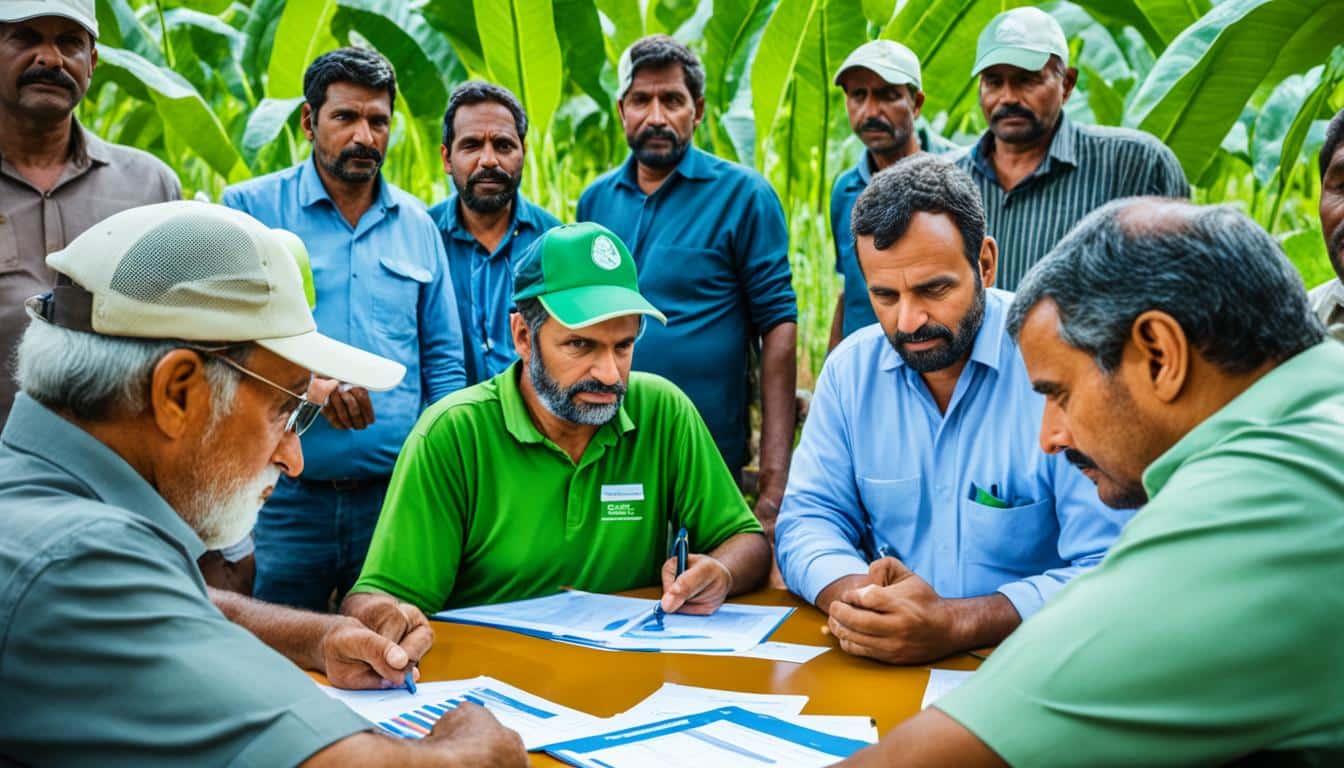
Have you heard about farm collaborations that range from simple agreements to more complex setups like co-ops and LLCs? They’re happening all over the country, from rural to urban areas like Phoenix, Los Angeles, Chicago, and Detroit. These efforts, taking place from 2022 to 2028, are crucial for making farming more modern and sustainable.
Collaborating with different groups, including institutions, organisations, and government agencies, these efforts push to improve how farming is done. They share knowledge, resources, and help boost the economy in the farming industry.
Collaborations between the government and farmers are key for making agriculture more sustainable. These partnerships use shared resources. They help in developing rural areas by bringing together knowledge, work, and tools.
Farmer collaborations mean working together between those who farm and those in the government. This teamwork can be anything from casual arrangements to formal businesses. They help share abilities, tools, and costs, making farming more efficient.
These partnerships are vital for keeping farming methods sustainable. They support long-term projects to develop rural areas. Incubator farms are especially important. They give new farmers access to support and skills, helping them start more easily.
Working together, though, also has challenges. These can include disagreements, issues with sharing profits, and differing personalities. But, organisations like the University of Arizona and SPROUT NOLA show that by working with farmers, the government can create rural development that is fair and good for the environment in the USA.
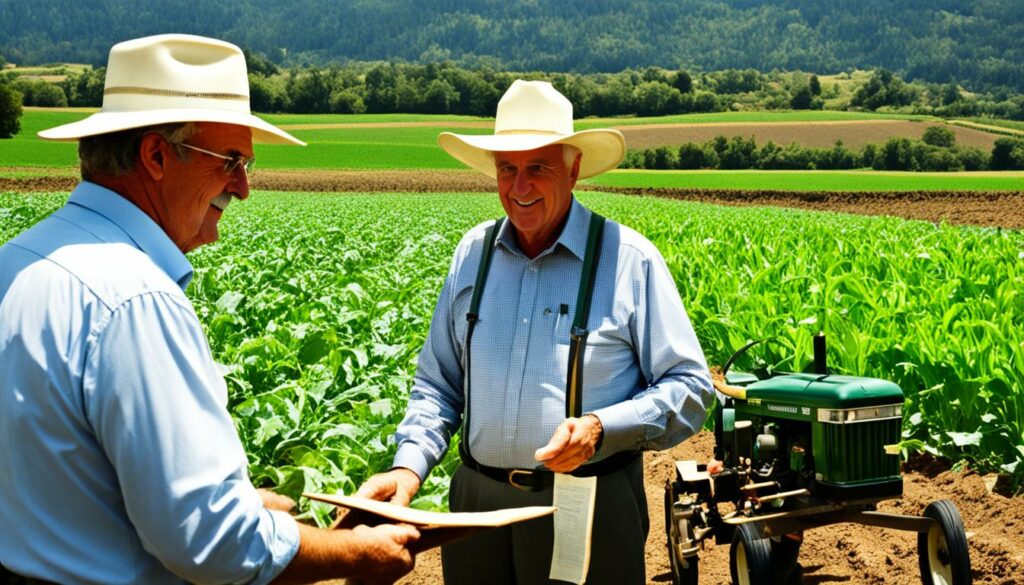
Agricultural collaborations have a deep history rooted in fighting poverty and boosting rural areas. In the 20th century, President Lyndon B. Johnson led actions against poverty in both towns and countryside spaces. The Appalachian Regional Commission was one such effort, bringing together 13 states to improve their local economies.
Since then, the idea of working together in farming has grown. For example, in 1972, the Consolidated Farm and Rural Development Act gave a big boost to this. It allowed for loans and grants through the USDA for rural development.
Things changed in the 1980s when President Ronald Reagan was in charge. The spending on rural programmes by the USDA got cut by more than half. This meant states and local communities, along with private companies, had to do more.
However, this didn’t stop the progress. Even with less money from the federal government, rural areas kept improving. This shows how flexible and strong the idea of working together in farming is.
Looking at Vietnam, there’s a fascinating story in agricultural development. For over four decades, farming has been key to their economy, feeding most of the rural population. Policy changes in 1986 turned the country into a major exporter, shipping goods like rice, coffee, and seafood worldwide.
There was a drop in the number of farming groups in Vietnam in the late 1980s. But, things turned around, and by 2020, the number of cooperatives was back up. Laws supporting the independence of farmers and their control over what they produce and sell were a big part of this success.
| Key Initiatives | Impact | t
|---|---|
| Appalachian Regional Commission | Promoted economic prosperity across 13 eastern states. | t
| Rural Community Development Service | Centralised rural economic development efforts. | t
| Consolidated Farm and Rural Development Act of 1972 | Provided legislative support for USDA Rural Development programmes. | t
| Decline and resurgence of cooperatives in Vietnam | Highlighted the role of flexible governance in agricultural resilience. | t
Vietnam’s shift after 1986 to a more open system has been crucial. New ways of working together have helped everyone make better decisions. This is important in making progress in those areas.
To sum up, the story of farm collaborations tells us a lot. It shows that working together and finding new ways to do so is very important. This is how farming has improved, helping grow economies and communities. Such teamwork lies at the core of modern, successful farming practices.
Farm collaborations have different shapes. They bring special advantages and challenges. Knowing them well helps to pick the best one for your situation.
Working together without formal paperwork is common among farmers. They might share tools, help with the work, and exchange tips. This way of working is easy-going and builds a strong community spirit.
But, it can sometimes cause problems. You might not have full access to what you need. Plus, there may be worries about money and if everyone will do their part.
Incubator farms help new farmers start. They provide land, tools, and advice. By joining, you get to be part of a group of farmers who support each other.
However, finding the right land or soil can be hard. This might make it tough for some to succeed at farming.
Cooperatives and LLCs are more official. They let farmers come together to do business. Everyone puts in resources and shares the work. This makes running the farm easier and fair for all. It also helps avoid possible fights over money or who makes decisions.
On the downside, setting up and keeping these groups going can be pricey and need a lot of paperwork.
“Sustainable agriculture projects thrive on the strength of these diverse collaboration models, leveraging shared resources to ensure long-term viability and success.”
Government-led farming collaborations can boost the success of sustainable projects. They do this by encouraging new ideas, sharing what works, and helping everyone grow together. Choosing the right way to collaborate is key to making these projects work well and last long.
The United States Department of Agriculture (USDA) is key in supporting agricultural partnerships. It does this by creating rules and help programmes. This ensures that farm team-ups follow the law and work well.

The USDA makes rules for partnerships between government and farming. These rules help farms to share resources, divide money, and join in research. All this makes farm partnerships run better.
State governments also have important rules for supporting farmers. They make rules that fit the unique needs of their area. They also give specific rewards. These state rules match the national ones and fit the local farming well.
By working together, the USDA and state rules really help farming teams. They allow farmers to work better and more earth-friendly. This partnership support is a big deal for the farming community.
| Framework Component | USDA Regulations | State-Level Policies |
|---|---|---|
| Scope | Federal Guidelines and Research | Localised Incentives and Solutions |
| Support Mechanisms | Funding and Research Initiatives | State-specific Grants and Programs |
| Regulatory Alignment | Federal Compliance | Local Compliance and Adjustment |
| Operational Focus | Nationwide Agricultural Practices | Regional Agricultural Dynamics |
Good government plans are key to encouraging new ideas in farming and helping farmers. They include money grants and chances for funding. These help farmers to update their ways and use new tech.
As the world’s population heads towards 9 billion by 2050, more food will be needed. To help, there’s the Global Food Security Act and its 2018 reauthorisation. These show how both sides in politics aim to fight global hunger and poverty by supporting farming.
The RAISE initiative by the USDA and DOE, for instance, aims to help 400 farmers with small wind projects. Also, the REAP programme got over $144 million from Biden’s Inflation Reduction Act. This supports new tech in farming, which helps the whole industry to grow in a better, greener way.
Grants and support from the government are crucial for improving how we grow our food. The DOE has set aside $4 million for better technologies in wind power. This includes $1.5 million for teaching and new business ideas. Plus, the USDA and DOE’s guide about small wind projects will offer in-depth help and advice.
Programmes such as the CRP, CSP, and EQIP show how the government stands behind farmers to improve the environment. They target sustainable practices and good land use. This shows the importance of federal support in helping farmers get the needed resources for healthier rural areas.
| Program | Purpose | Funding |
|---|---|---|
| RAISE Initiative | Supporting small-scale wind projects | 400 farmers targeted |
| REAP Program | Funding for underutilized technologies | $144 million |
| Global Food Security Act | Alleviating hunger and poverty | Bipartisan support |
| Conservation Reserve Program | Improving environmental health | Rental payments |
| Conservation Stewardship Program | Strengthening operations | Ongoing support |
| Environmental Quality Incentives Program | Integrating conservation | Flagship program |
Collaborative farming has proven to boost sustainable agriculture in great ways. After looking at 30 cases in the EU, it’s clear that working together helps both productivity and sustainability. The study focused on many areas to see what made these projects work well.
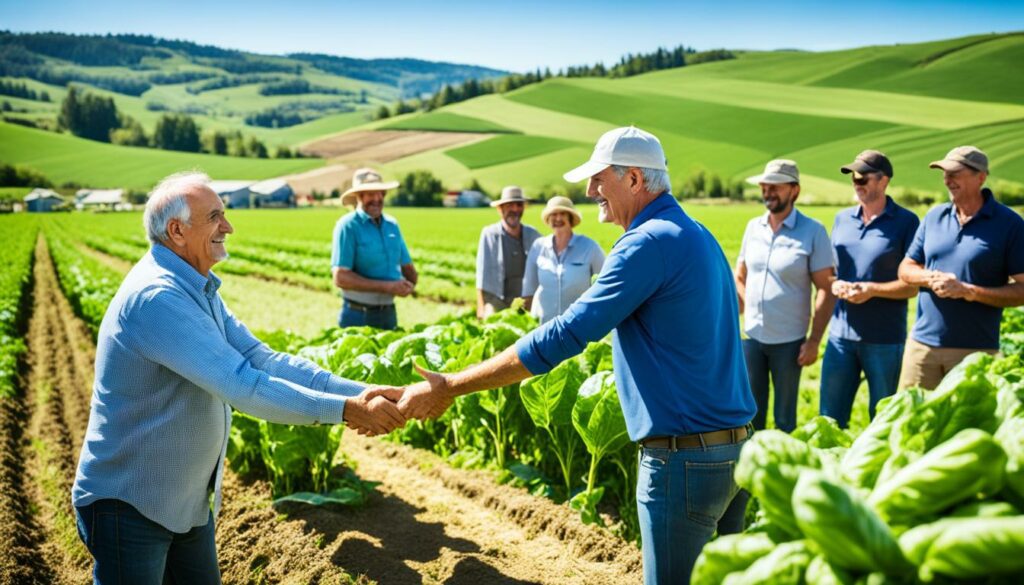
What’s interesting is that the groups’ own efforts mattered more than outside factors. By collaborating, farmers got better at negotiating and got more money to work with.
Urban Edge Farm leads by example in showing how shared spaces can help new farmers. With joint investments, funding help, and sharing knowledge, it supports budding farm talents. Their approach to farming ensures they meet social, economic, and environmental goals.
Elmer Farm’s move from shared to owning land highlights the value of training and access to land. They show how working in different business models that support each other helps them grow. They balance social and economic aims well, making their farming work.
The start of a joint project in farming isn’t as important as making it work over time. Understanding how people and organizations affect a project is key to success. Good farming partnerships bring together people and make it easier to sell products.
In the end, successful farming needs strong teamwork. When farms work together, they can achieve more and do better.
Collaborative farming lets farmers join forces. They share skills, knowledge, labour, and more. They work together to achieve common goals. This approach boosts their marketing plans, sales, and business strategies. It makes farming more efficient and resilient by sharing strengths and risks.
Yet, there are hurdles in collaborative farming. Issues like partner disputes or disagreements on profit sharing can come up. Also, not all collaborators may put in the same effort. This can lead to tension or uneven workloads. And it’s tough to get out of the partnership once you’re in. When farms share customers, problems coordinating who gets what profit can appear. There might also be disagreements on how to run the farm.
| Collaborative Farming Benefits | Farming Partnerships Challenges |
|---|---|
| Resource Sharing | Disputes Among Collaborators |
| Cost Savings | Profit-Sharing Issues |
| Shared Knowledge | Personality Conflicts |
| Increased Negotiation Power | Unequal Effort or Resources |
| Joint Investments | Lack of Shared Expectations |
| Receiving Funding | Difficulty Exiting Arrangements |
| Enhanced Efficiency | Shared Customer Base Issues |
| Knowledge Sharing | Profit Liability |
Informal farm teams often form without formal papers. They offer flexibility but not the security seen in the structured groups. In contrast, incubator farms support newcomers with essentials and mentorship. They make it easier to start but may not be best for all crops due to soil and land challenges.
In my view, government-backed farm collaborations are key for sustainable farming. A study of 30 EU cases found that the group’s inner workings are more vital than outside elements. It showed that having power within these groups is crucial. Also, teaming up boosts relationships, a sense of community, advice sharing, and benefits the environment and economy.
Sustainable agriculture projects play a vital role in farming today. They help keep the earth healthy while also boosting the economy. These projects use holistic solutions to meet social, economic, and environmental needs. This makes them key drivers of good changes.
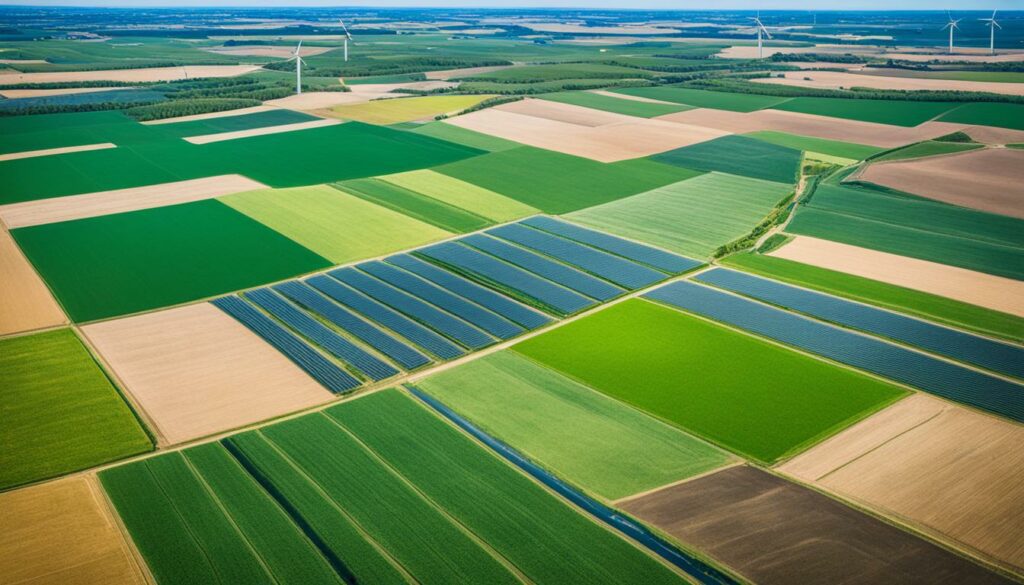
Sustainable agriculture has a huge environmental impact. Projects work together through public-private partnerships (PPPs) to improve the soil, support wildlife, and cut down on greenhouse gases. For example, the Farmers for Soil Health Climate-Smart Commodities Partnership aims to introduce cover crops on 1 million acres across the USA. This will make for healthier natural areas. The Midwest Climate-Smart Commodity Program measures how planting these crops lowers harmful gases and adds to the soil. These steps help the environment in real ways.
Sustainable farming also helps the economy. Thanks to new farming technology and the help of PPPs, farms become more efficient and profitable. For instance, projects like Strengthening Grassroots Leadership benefit from nearly $90,000,000 in funding. They help farmers get more finance and improve their methods. This makes them earn more. Plus, the ADM and Partners’ Climate-Smart Solutions project shows how selling ‘green’ products at a greater price can support eco-friendly farming throughout the market.
| Project | Goal | Funding | Impact |
|---|---|---|---|
| Farmers for Soil Health Climate-Smart Commodities Partnership | Implement 1 million acres of cover crops | $95,000,000 | Environmental and economic benefits |
| Midwest Climate-Smart Commodity Program | Track nitrous oxide emission reductions | N/A | Improved soil health and carbon sequestration |
| Strengthening Grassroots Leadership and Capacity | Support climate-smart practices across various commodities | $90,000,000 | Enhanced efficiency and profitability |
| Climate SMART Project | Equip underserved producer organizations with sustainability tools | $90,000,000 | Economic empowerment of underserved communities |
| ADM and Partners’ Climate-Smart Solutions | Engage underserved producers to promote climate-smart agriculture | N/A | Sell climate-smart products at a premium |
Public and private groups working together are key in enhancing farming sustainably. They use government, non-profit, and business help to face green challenges. These partnerships use a lot of resources. They boost farming output and introduce new tech.
Ireland is a great example. In the 1990s, a lot of Ireland’s people worked on small farms. But, the farming sector there changed fast. Now, Ireland is famous for safe food, traceability, and caring for the planet.
Public-private partnerships push for smart policies in farming. They focus on keeping farming methods kind to nature, tough, and fair for all.
These partnerships are vital for new ideas and research in farming that helps the planet. By working together, they make it easier to afford green farming projects. This includes helping farmers adapt to climate change with new tech and ways to grow food.
In 2017, a workshop in Ireland brought ten African countries together to talk about farming. This led to big projects in Kenya and Uganda. These projects made the farming business more innovative and effective.
Another good event happened in 2019, in Kigali. It brought African leaders and food industry experts together to talk about farming better. Events like this show how working together makes a big difference.
In America, the USDA helps by guaranteeing most of a loan’s cost. This gets private lenders more involved. Also, it ensures private crop insurance pays claims fast. By mixing government help with private business, farming gets a big boost.
The US government works closely with Tribal Nations. This partnership is special, aiming to include tribal voices in making agricultural policies. They also want to highlight the valuable contribution of Tribal Nations to farming.
Indigenous knowledge is also key. It helps in understanding and using ancient farming methods. Tribes used to eat various foods like buffalo, fish, and corn. Today, it’s important for the health and culture of many Native American groups to have control over their food sources.
Training in areas like farming and support for food businesses is critical. It helps these communities be more independent and financially stable. For many Native people, getting healthy food, especially now during the COVID-19 pandemic, is hard.
George Washington University and Virginia Tech are working with tribes to improve their food systems. This also helps in promoting tourism focused on Native foods. They aim to help Tribes start food-related businesses for more financial power.
To make these partnerships work, there are specific policies in place. For example, new farmers and ranchers can get Farm Loans to help them start. There are also special loans for those hit by disasters.
The Indian Tribal Land Acquisition Loan Program helps buy land in reservations for farming. This aids in farming and helps nature conservation too.
The Native American Agriculture Fund offers grants for agricultural learning and business help. During disasters, FEMA Tribal Liaisons step in to help. Another grant aids Tribes in preparing new business projects, helping them prosper.
Energy is also a big focus. Programs support clean energy and energy efficiency on Tribal Lands. These efforts not only help support renewables but also educate tribes on managing energy projects.
The aim of all these rules and actions is clear. They want to strengthen the bond between the government and Tribes. This should make sure tribal ways are well-considered in federal plans.
| Programme | Description | Benefit |
|---|---|---|
| Farm Loans | Loans for beginning farmers and emergency loans for disaster-affected operations | Facilitates economic resilience and recovery |
| Native American Agriculture Fund | Grants for education, business assistance, and technical support | Enhances agricultural knowledge and business acumen |
| FEMA Tribal Liaisons | Support during federally declared disasters | Provides critical disaster response and recovery aid |
| Energy Infrastructure Deployment | Grants for clean energy and energy efficiency projects | Boosts energy sustainability and resilience |
Collaborative farming is more vital than ever. Farmers join forces to boost their productivity by sharing resources. Yet, this teamwork isn’t always easy. Challenges in collaborative farming can slow things down. It’s key to know these issues and how to fix them to keep partnerships strong.
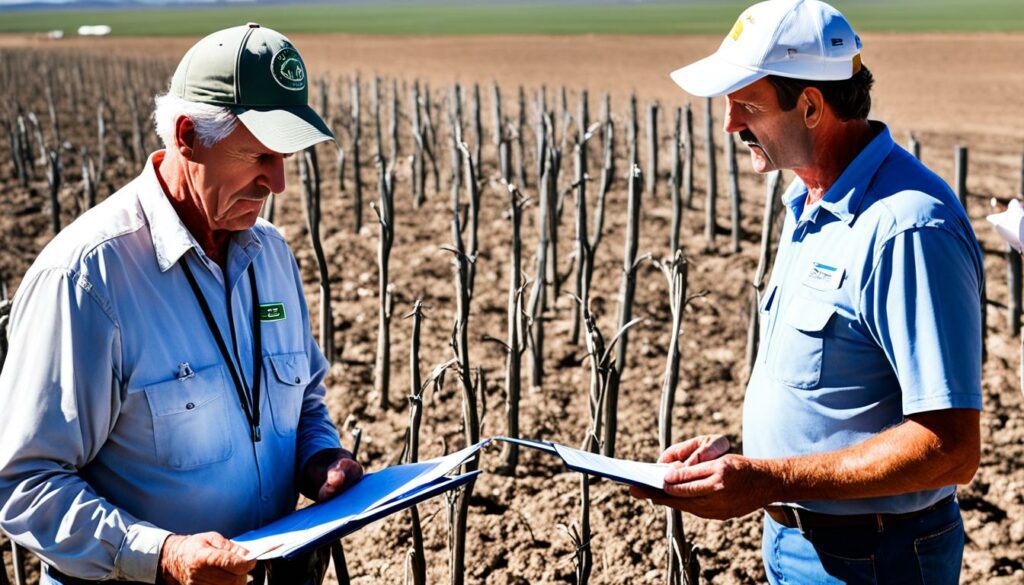
When farmers don’t see eye to eye, it can really slow the team down. This might happen because they don’t agree on how to farm or because their personalities clash. To keep things moving, it’s important to solve these issues in a smart way:
By following this plan, the team can tackle problems head-on. This keeps everyone happy and the work environment friendly.
Dividing up the profits can get tricky. It’s easy for someone to feel like they’re not getting their fair share. To avoid this, finding the right profit-sharing method is key:
Handling how the profits are shared well is crucial. It makes sure everyone feels appreciated and fairly treated.
The future of farming is changing because of new technology and more people getting involved. These changes could add a lot of value to the world economy in the next ten years. By 2030, connecting more things in the farming world could bring in an extra $500 billion. This is important because more people will need food, requiring a big increase in what we grow.
But there are big problems to solve. A lot of farmable land is not used well and needs fixing. Plus, the water we need for farming might not be enough by 2030. This makes working together between governments and farmers key to finding ways to farm better for the long term. With only a quarter of U.S. farms using new tech so far, there’s huge potential to do more with better connections.
Future farming will blend new tech together in smart ways. Things like AI and special maps will help make farming less harmful to the environment. New tools, like feed additives that cut down on gas from animals, will also be very important.
In the near future, governments and farmers will work more closely than ever. They aim to make what we eat better for the planet. By 2030, most rural places in the world should have better internet. This will help farms do their jobs more efficiently and with less impact on the environment.
The Food and Agriculture Organization (FAO) points out 18 main changes coming in how we grow food. From political trouble to using up resources, we need to be ready for a lot. The FAO says we should plan for different futures. They suggest more of the same, making changes, competition, or working together for the environment. These different ways can help us face the future in farming smarter.
| Trend | Impact | Potential Value |
|---|---|---|
| Advanced Connectivity | Enhanced data access and management | $500 billion additional GDP by 2030 |
| Technological Integration | Improving productivity and reducing emissions | 2-3 trillion USD value to global GDP |
| Stakeholder Engagement | Promotes sustainable practices | Critical for long-term viability |
To meet the goals set by the United Nations, farming must change a lot. This change, led by new tech and everyone working together, can bring big benefits. Food makers and governments need to work closely to make this happen. Starting now to plan and act will help farming become better for the future.
Starting agricultural partnerships is key for both sustainable farming and growth. It’s crucial to carefully plan and understand the steps, including legal ones. We’ll explore the main steps for these collaborations and the key legal considerations.
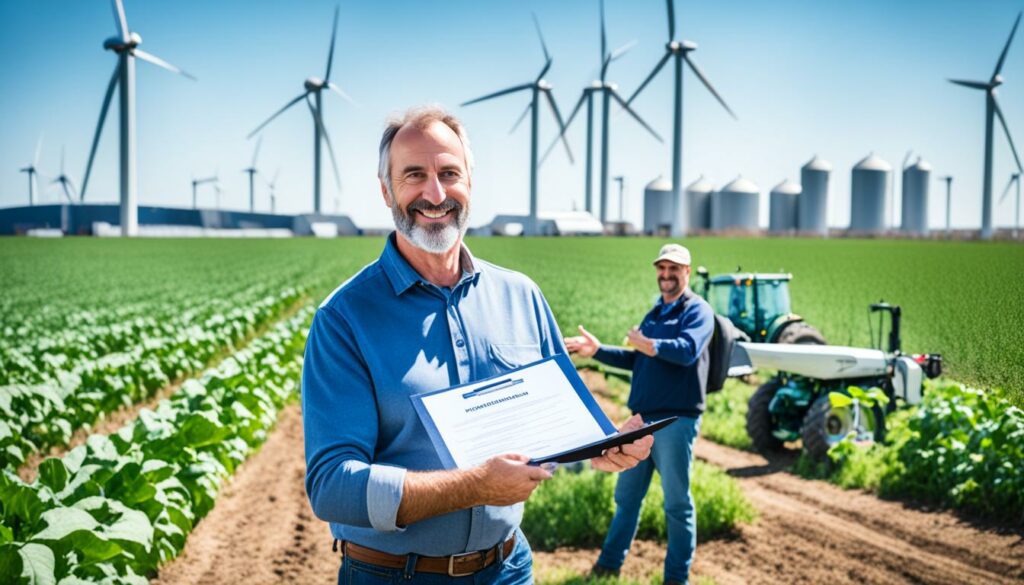
Knowing the legal side is critical for the success and sustainability of your partnerships. Here are some important things to keep in mind:
By keeping these steps and legal points in mind, you set up a good foundation for your agricultural partnerships. Remember, careful planning and understanding each other well are vital for success and sustainability in farming collaborations.
Working together, governments and farmers have greatly improved agriculture. They have helped make farming more efficient, sparked new ideas, and protected countryside communities. Vietnam is a standout example. In the last 40 years, agriculture not only gave jobs to over half the rural people but also earned more money from exports than it spent.
In 1986, Vietnam’s farming journey changed with the Đổi mới policy. This change turned the country from a net food buyer to a major seller. Now, exports include rice, coffee, pepper, and more, reaching global markets. This success highlights the role of smart leadership and working together, especially since the early 2000s.
To benefit, working relationships must keep getting stronger. For example, projects like the Project Coordinating Committee (PCC) from CARE International have shown great results. They were used in the Dairy Development Programme. These efforts prove that with the right support, farming can flourish. Despite some issues, teamwork through local councils can help share knowledge widely. In the end, ongoing cooperation between the government and farmers makes a country’s agriculture thrive, just like in Vietnam’s story.
Government farmer collaborations bring farmers and government together. Their goal is to make farming better, greener, and to help farmers out. They share tools, new ways of doing things, and set rules that help.
Agricultural partnerships are key in making farming last. They join farmers and share ideas, gear, and help out in the countryside. This sharing improves how much food is grown, sparks new ideas, and boosts the economy in far-off places.
Farming cooperation started a long time ago with both old and new groups working together. These partnerships have always aimed to make farming better, by being more productive and creative.
There are many ways farmers can work together. This can be by just helping each other out casually. Or, more formally, by sharing land and skills with new farmers. There are even special business types for big farming projects. Each way has its own good points for those involved.
The USDA helps these farming deals work well by setting up useful rules. These rules guide farmers in working together in good, sustainable ways. They make sure that teaming up helps everyone and the land.
There are lots of programs that give farmers a hand with money and new tech. They help farmers grow more food, learn new skills, and take care of the land. These schemes are vital for the farm world.
Places like Urban Edge Farm and Elmer Farm show how working together can start small and grow big. They began by sharing resources and knowledge, turning dreams of farming into successful businesses. Access to land and learning is key here.
Working together in farming has good sides, like saving money and learning from each other. But it’s not always easy, with issues like sharing profits and making decisions. Talking things through and planning well can beat these problems.
Sustainable farming helps the environment and makes more money. It keeps the soil healthy, supports more plants and wildlife, and boosts profits for farmers. For farming to last, this eco-friendly way is a must.
Public and private groups coming together make farming better and more creative. They bring in a lot of cash, help with research, and make the rules work with what’s real on the farm. This teamwork helps farming move forward.
Working with Tribal Nations is special because it’s like governments talking to each other. It makes sure that native ways are part of farming policies. Including native knowledge honours their farm wisdom and meets their unique needs.
There are smart ways to deal with teamwork troubles, like setting up fair ways to solve fights and share profits. These methods keep everyone happy and help teams in farming last long and do well.
Farming together will be more about everyone joining in, using high-tech gear, and looking after the earth. This path will lead to smarter, greener ways of farming for the future.
To get started, pick who you want to work with and decide what you all want to achieve. It’s also very important to make things clear in writing and know the laws. These steps make sure your farming project starts strong and stays that way.